This article was medically reviewed by Erik Kramer, DO, MPH. Dr. Erik Kramer is a Board-Certified Primary Care Physician at the University of Colorado. With over 15 years of experience, his clinical interests include obesity and weight management, diabetes care, and preventive care, as well as embracing a holistic approach to primary care. He received his Doctorate in Osteopathic Medicine (D.O.) from the Touro University Nevada College of Osteopathic Medicine and completed his residency at Central Maine Medical Center. Dr. Kramer is a Diplomate of the American Board of Obesity Medicine.
There are 12 references cited in this article, which can be found at the bottom of the page.
This article has been viewed 123,566 times.
Experts say cleaning a wound before applying bandages helps prevent an infection and may speed up the healing process.[1] To clean your wound, you'll need to rinse the area with running water and remove any debris. Research suggests that you can use sanitized tweezers to remove stubborn debris, but you need to see a doctor if you can't get it all out.[2] While you can typically clean a minor wound at home, consult your doctor if you can't stop the bleeding, your wound is very deep, or you notice signs of an infection.
Steps
Cleaning the Wound
-
1Examine the wound. The first step in treating any injury is to examine it closely. You'll need to determine the nature and severity of the wound. Take a close look at the injury and pay attention to the following:[3]
- The amount of blood. How rapidly is the person bleeding? Does the blood come out in a steady flow, or is it pulsing?
- Foreign objects in the wound. This might be the cause of the wound itself, like a fishhook, or a piece of glass.
- Dirt or debris in or around the wound.
- Evidence of a bone fracture, like a protruding bone, swelling over a bone, or inability to move a limb. Look for this especially if the person was injured in a fall.[4]
- Evidence of internal bleeding, like swelling, large purple areas on the skin, or abdominal pain.[5]
- In the case of animal attacks, look for signs of bites and multiple injuries. If you live in an area where there are venomous snakes or insects, it may be helpful to know what those injuries look like. If you suspect the animal has rabies, seek medical attention immediately to prevent infection or complications.
-
2Determine if medical attention is needed. You can often treat minor wounds at home. But, in the case of a serious wound, the injured person should see a doctor immediately. Seek medical attention if:
- The wound is bleeding a lot, the bleeding is pulsing, and/or it won't stop.
- The wound is more than one centimeter deep. This may require stitches.
- There is any significant head trauma.[6]
- There is evidence of a bone fracture or internal bleeding.[7]
- The wound is dirty and the injured person has not had a recent tetanus vaccination.[8] This is especially important if the wound came from a rusty metal object.
- The person is known to be taking blood thinners. This is especially important if the person has suffered head trauma.
Advertisement -
3Stop the bleeding. Apply gentle pressure to the wound using a wad of cloth or gauze, with excess fabric wrapped around the wounded area. Elevate the wounded area above the person's heart, if possible.
- Elevating the wounded area will decrease blood flow to the wound and decrease bleeding.
- If bleeding doesn't stop within 10 to 15 minutes, seek immediate medical help.[9]
-
4Remove small foreign objects. If there are any objects in the wound that you can remove (such as a small rock, splinter, or fishhook), carefully take them out.
- Use sanitized tweezers for small objects if you have them available.
- Do not remove large objects from a wound. You can further open the wound and increase bleeding.
- If there is a large amount of debris in the wound, especially if the wound is large (e.g. a "road rash" injury), seek medical attention. Removing the debris can require painful scrubbing, and a local anesthetic may be a good idea.
-
5Irrigate the wound. Once the bleeding has stopped, the next step is thoroughly cleansing the area with warm, flowing water. This is arguably the most important step for promoting speedy recovery.[10] There are several good ways to do this:
- Use a bulb syringe (available in most drug stores) filled with warm tap water or normal saline (you can use a large bottle of saline solution for contact lenses if you're in a pinch). Squeeze the liquid out onto the wound. Repeat for a volume of approximately two liters. You won't need to irrigate as much on the face or scalp. These areas have many blood vessels and will clean the wound naturally through bleeding.
- A 60cc syringe with IV catheter tip provides the best volume and pressure of irrigation. It also provides directed irrigation to get behind skin flaps and other difficult areas. If you go to a doctor for care, this is most likely what he or she will use.
- You can also use running warm tap water. Run at least two liters, the size of a large plastic soda bottle, over the wound. Continue until all wound areas are free of debris and all flaps cleaned under.
- Wounds from burns should be generously irrigated with cool water to bring down temperature. In the case of chemical burns, irrigation dilutes the chemical and reduces tissue damage.
-
6Bandage the wound. After cleaning the wound, wrap it in a clean bandage. Bandaging restricts mobility so that wound edges can come together and heal. It also protects from further injury and infection.
- Use a bandage that is slightly larger than the wound itself.
- Any commercially available bandage material will work for most wounds. Gauze is the mainstay, either rolled or in 2x2 or 4x4 options depending on wound size.
- Burns, abrasions, or wounds with irregular edges should be covered with a non-stick or Telfa pad, as dried blood and healing skin can stick to gauze.
- Iodine impregnated gauze is best for wounds that need to stay open, such as abscesses or puncture wounds.[11]
Managing the Wound
-
1Reexamine the wound daily. After 48 hours, recheck the wound daily. Carefully remove the bandage and look for signs of infection or other complications. Contact a doctor if you see signs of infection.
- If the bandage is crusted on to wound and won't come off easily, soak it in warm water.[12]
- While the wound is exposed, assess for signs of infection. These include redness of the skin around the wound edges or progressing up the injured limb, warmth around the wound, and swelling. Look for drainage of pus or that is greenish-yellow in color.[13]
- Check the injured person's temperature for fever. Anything of 100.4 or above is cause for alarm, and you must seek immediate medical attention.
- If an infection becomes trapped inside the skin, the wound may need to be reopened by a doctor. Some infected wounds require antibiotics or even an operation under general anesthesia. This is especially common in cases where the wound was not irrigated properly.
- If you have a chronic skin wound or ulceration, go to a wound care clinic to get treatment or topical antimicrobials. Those with diabetes mellitus and peripheral vascular disease are at risk of worsening complications with non-healing wounds.
-
2Irrigate the wound. If the wound is clean, irrigate again to maintain cleanliness. Just run water over the wound for one minute. Wash any clotted blood off with soap and water.
- Use soap and water to clean the surrounding skin and parts of the wound that are not wide open. Sing the birthday song twice while washing the area and you will have done a thorough job!
Warning: Do not apply antiseptic or topical cleansers directly onto an open wound since it could prevent healing. Only apply it to skin that’s completely closed.
-
3Apply an antibiotic. Once you cleanse the wound, apply a small coating of Neosporin or another topical antibiotic ointment to the wound with a Q-tip. This reduces the chances of infection.[14]
- This is not a substitute for thorough cleaning and irrigation. Apply sparingly, and if the wound is macerated, let it dry before applying any ointment.
-
4Bandage the wound. Place a clean bandage over the wound. Between inspections, keep the bandage clean and dry.
- Repeat the inspection process daily until the wound is healed.
- Continue to elevate wound as much as possible, for at least the first few days. This will minimize the pain and swelling.
Warnings
- Be aware that HIV and other diseases can be transmitted through blood. When cleaning another person's wound, it is always a good idea to wear latex gloves and avoid contact with blood.⧼thumbs_response⧽
- If the wound becomes infected, feels warm to the touch, discharges pus, or has expanding redness, seek professional medical help quickly.⧼thumbs_response⧽
References
- ↑ https://www.nhs.uk/common-health-questions/accidents-first-aid-and-treatments/how-do-i-clean-a-wound/
- ↑ https://health.clevelandclinic.org/handling-injuries-from-small-cuts-to-serious-wounds/
- ↑ Bret Nicks, Elizabeth Ayello, Kevin Woo, Acute Wound Management : Revisiting the approach to Assessment , Irrigation and Closure, Journal of International Emergency Medicine, 2010, Dec, 3 (4) 399-407)
- ↑ https://health.clevelandclinic.org/handling-injuries-from-small-cuts-to-serious-wounds/
- ↑ https://www.ncbi.nlm.nih.gov/books/NBK542273/
- ↑ https://www.mountsinai.org/health-library/injury/head-injury-first-aid
- ↑ https://www.pennmedicine.org/for-patients-and-visitors/patient-information/conditions-treated-a-to-z/bone-fractures
- ↑ Center for Disease Control. Tetanus Vaccines for Wound Management.
- ↑ Hoffman, R. Benz E.J. Jr., and L.E. Heslop. Hematology: Basic Principles and Practice. Laboratory Evaluation of Hemostatic and Thrombotic Disorders
- ↑ Bret Nicks, Elizabeth Ayello, Kevin Woo, Acute Wound Management : Revisiting the approach to Assessment , Irrigation and Closure, Journal of International Emergency Medicine, 2010, Dec, 3 (4) 399-407.
- ↑ Bret Nicks, Elizabeth Ayello, Kevin Woo, Acute Wound Management : Revisiting the approach to Assessment , Irrigation and Closure, Journal of International Emergency Medicine, 2010, Dec, 3 (4) 399-407)
- ↑ https://cert.vohrawoundcare.com/how-to-change-a-wound-dressing/
- ↑ https://www.ncbi.nlm.nih.gov/books/NBK482198/
- ↑ https://health.clevelandclinic.org/handling-injuries-from-small-cuts-to-serious-wounds/
About This Article
To clean a minor wound, start by wrapping a wad of cloth or gauze around the wounded area to stop the bleeding. Then, elevate the area above your head, if possible, to decrease blood flow to the wound. Remove the gauze after 10 to 15 minutes, then use a sanitized tweezer to remove any small objects from the wound. Afterwards, run 2 liters of warm tap water over the wound to thoroughly cleanse the area. Finally, wrap the wound in a clean bandage to prevent further injury and infection. For more advice from our Medical reviewer, including how to tell when you should see a doctor, keep reading.
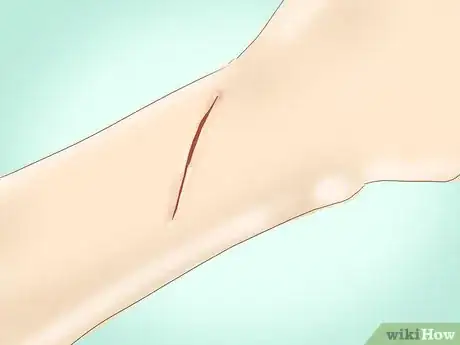
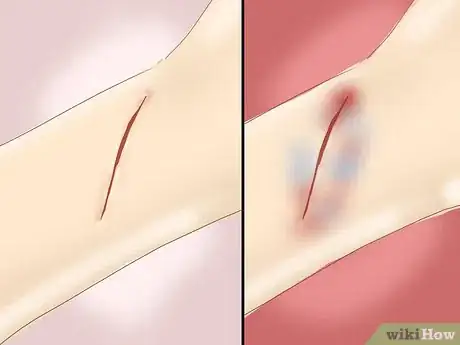
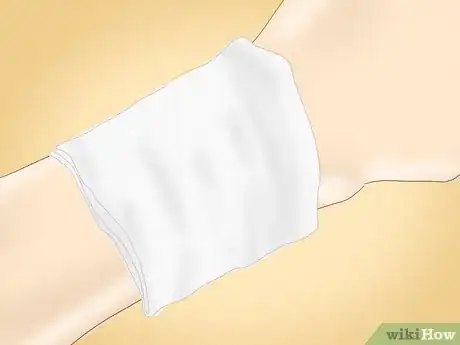
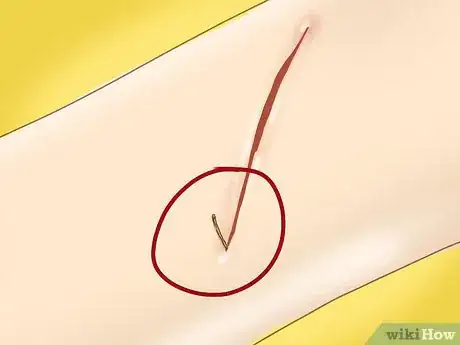
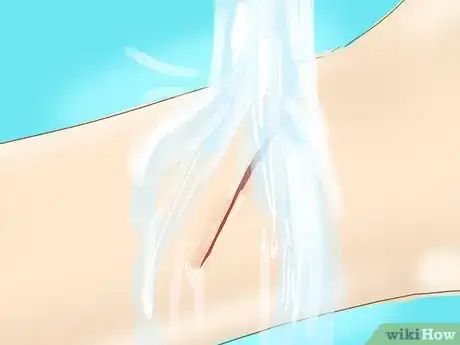
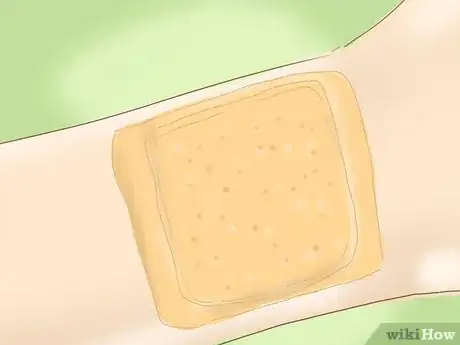


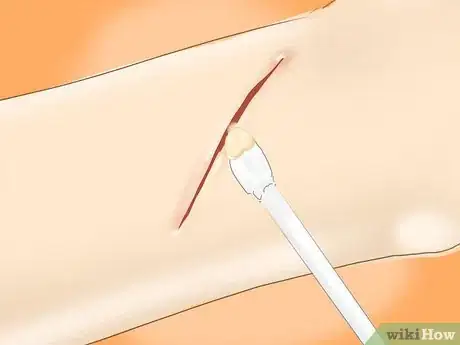


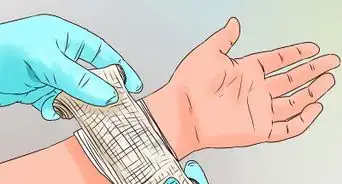

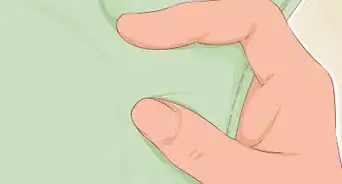
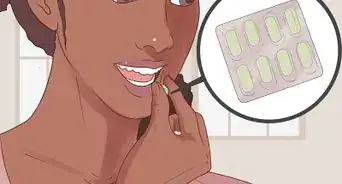








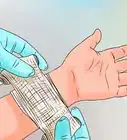

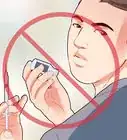



































Medical Disclaimer
The content of this article is not intended to be a substitute for professional medical advice, examination, diagnosis, or treatment. You should always contact your doctor or other qualified healthcare professional before starting, changing, or stopping any kind of health treatment.
Read More...